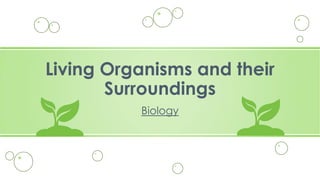
Living Things and Their Surroundings
- 1. Living Organisms and their Surroundings Biology
- 2. Non-Living Things o Things that don’t need air, water, food and sunlight for their existence are known as NonLiving Things. o Example- table, chair ,rocks etc.
- 3. Living things o Those things that need air, water, food and sunlight to survive are known as living things. o Example- plants, animals and human beings.
- 4. Characteristics of Living Things 1. Living things need air, water and food. 2. They can grow. 3. They can move on their own. 4. They can respond to stimuli (changes around them) because they are sensitive. 5. They respire (breathe) 6. They excrete. 7. They reproduce. 8. They have a definite life-span.
- 5. 1. Food o For all living things to exist, they need food and water. o Plants- They make their food by doing the process of photosynthesis. o Animals- They obtain their food from other living organisms like grass and other animals. o Humans- Even we feed on other living organisms.
- 8. 2. Growth o The young ones of living organisms grow or increase in size as time passes away. Soon they become an adult. o Plants- Their seeds grow up and become a mature plant in the future. o Animals- Their babies grow up to become strong animals like their mom and dad. o Humans- Their babies grow up to become strong adults like their mom and dad.
- 9. Growth of a Plant
- 10. Growth of a Human
- 11. 3. Movement o All living things move themselves without any external help. o Plants- Lets take the example of a ‘touch me not plant’. If you touch it it closes its leaves. This shows movement in the plant. o Animals- They move to hunt for food, etc. o Humans- They move to do their occupations like running, walking, driving etc.
- 13. 4. Respond to Stimuli o All living thing respond to changes around them. o Plants- Lets take the example of a touch-me-not plant. When you touch that plant, it closes. So it responds to stimuli. o Animals- When a deer feels a scratch on her back, she understands that something hurt her, so she runs away. So it responds to stimuli. o Humans- When we touch fire, out hand moves away on its own. So we responds to stimuli.
- 15. 5. Respiration o All living things undergo respiration to obtain energy from food. o Plants- Plants take in carbon dioxide and give out oxygen. They respire. o Animals- Animals take in oxygen and give out carbon dioxide. They respire. o Humans- We take in oxygen and give out carbon dioxide. We respire.
- 16. o Each living thing breathes through different parts of their body.- 1. Plants- Stomata(small openings in leaves) 2. Sea animals like fish- Gills (organs which absorb oxygen mixed in water) 3. Mammals like humans- Lungs 4. Animals like earthworms- Moist skin
- 18. 6. Reproduction o The process by which all living things give birth to their young ones is known as reproduction. This doctor is checking the Lama’s baby inside the Stomach.
- 19. o Animals reproduce through- 1. Eggs (chickens, etc) 2. Giving birth to their young ones directly (humans, cows, etc) o Plants reproduce through- 1. Seeds (fruits like mangoes, plums, etc) 2. Tubers (potatoes) 3. Plant cuttings(rose)
- 20. 7. Excretion o The removal of waste materials from the body is known as excretion. o Plants excrete through- 1. Taking out carbon dioxide or oxygen depending on day and night. 2. Storing their waste products in their fruits, leaves, barks, etc. 3. Secretions (gum, raisin and wax) o Animals excrete through- 1. Urine 2. Faeces 3. Exhaling carbon dioxide
- 21. 8. Definite Life-Span o All living things start their life and end their life in a specific time. Thus, all living things have a definite Life-Span. o For example, a turtle has a life-span of more than a 100 years but average humans have a life-span of only 60-70 years old.
- 22. Habitat o A place or surrounding where a living organism lives is called its habitat. o See the picture of a forest…identify the animals living in this habitat.
- 23. Types of Habitats 1. Terrestrial Habitats- Habitats on land like deserts, rainforests, etc. 2. Aquatic Habitats- Habitats in water bodies like lakes, seas, etc. Terrestrial Habitats Aquatic Habitats
- 24. Biotic Components o Living things are their habitat’s biotic components. o Example- A desert’s biotic components are camels, cactuses, etc. A river’s biotic components are fish, crabs, etc. The Camels are the biotic components of a desert.
- 25. Abiotic Components o The Non-Living things are their habitat’s abiotic components. o Example- A desert’s abiotic components is sand, etc. A river’s abiotic components is water, etc. A river’s abiotic components is water.
- 26. Adaptations o The presence of a specific body features (or certain habits) which enable a plant or an animal to live in a particular habitat is called adaptation. o For example- The polar bear is adapted to snow and the cold weather. But the camel is adapted to the hot sand and hot weather. So if we bring the polar bear to the desert and the camel to the North Pole, they both won’t be able to survive because they are not adapted to have the special features which they need to survive there.
- 27. By: Shubhra
